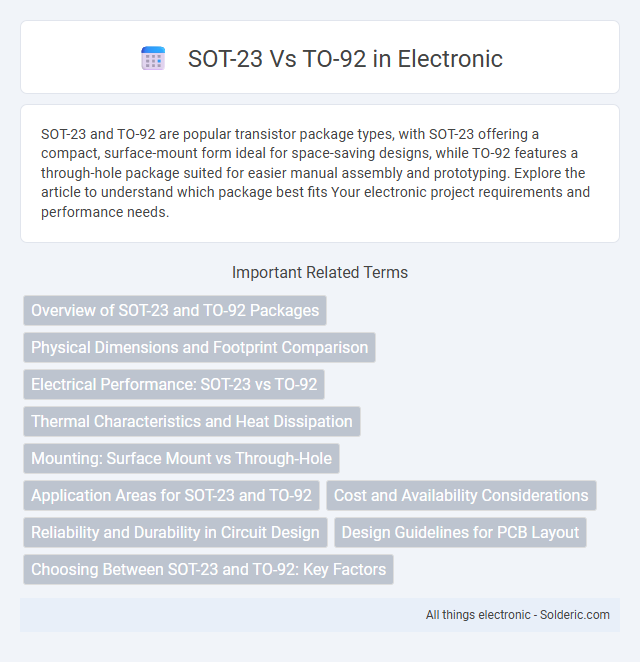SOT-23 and TO-92 are popular transistor package types, with SOT-23 offering a compact, surface-mount form ideal for space-saving designs, while TO-92 features a through-hole package suited for easier manual assembly and prototyping. Explore the article to understand which package best fits Your electronic project requirements and performance needs.
Comparison Table
| Feature | SOT-23 | TO-92 |
|---|---|---|
| Package Type | Surface-Mount Device (SMD) | Through-Hole |
| Dimensions | 2.9mm x 1.3mm x 1.1mm | 4.5mm x 4.5mm x 4.7mm (approx.) |
| Mounting Style | PCB Surface Mount | Leaded Through-Hole Mount |
| Thermal Resistance | Higher, less heat dissipation | Lower, better heat dissipation |
| Application | Compact circuits, space-saving | Prototyping, ease of handling |
| Lead Configuration | 3 leads, closely spaced | 3 leads, spaced apart for breadboards |
| Cost | Usually lower for mass SMD production | Often higher due to through-hole packaging |
Overview of SOT-23 and TO-92 Packages
SOT-23 and TO-92 packages are widely used semiconductor packaging formats with distinct features suited for different applications. The SOT-23 package, a small-outline transistor package, offers a compact, surface-mount design ideal for high-density PCB layouts and automated assembly processes. In contrast, the TO-92 package is a through-hole format known for its ease of prototyping, robust mechanical stability, and suitability for low-power discrete transistors and sensors.
Physical Dimensions and Footprint Comparison
The SOT-23 package measures approximately 2.9 mm x 1.3 mm with a low-profile height of around 1.1 mm, offering a compact footprint ideal for high-density PCB layouts. In contrast, the TO-92 package is significantly larger, typically about 4.7 mm in diameter with a length of 4.9 mm, resulting in a footprint that requires more board space and through-hole mounting. The smaller SOT-23 size supports surface-mount technology (SMT), enabling automated assembly and reduced parasitic inductance, while the TO-92 is mainly used for through-hole applications with simpler prototyping and manual soldering.
Electrical Performance: SOT-23 vs TO-92
SOT-23 packages offer superior electrical performance with lower parasitic inductance and capacitance compared to TO-92, making them ideal for high-frequency applications. The smaller size and improved thermal characteristics of SOT-23 contribute to better switching speeds and enhanced signal integrity. Your choice between SOT-23 and TO-92 directly impacts circuit efficiency, especially in compact or high-speed electronic designs.
Thermal Characteristics and Heat Dissipation
SOT-23 packages offer lower thermal resistance, typically around 200degC/W junction-to-ambient, enabling better heat dissipation in compact surface-mount designs compared to TO-92, which has thermal resistance near 300degC/W. The TO-92's larger body allows for improved heat spreading but is limited by its through-hole mounting, which affects thermal conduction paths. Effective heat dissipation in SOT-23 relies on PCB copper area and thermal vias, while TO-92 benefits more from airflow due to its protruding lead structure.
Mounting: Surface Mount vs Through-Hole
SOT-23 packages employ surface mount technology (SMT), offering compact size and ease of placement on printed circuit boards (PCBs) with automated assembly processes. TO-92 packages feature through-hole mounting, requiring leads to be inserted into drilled PCB holes, providing mechanical stability ideal for prototyping and manual soldering. Surface mount SOT-23 components enable higher component density and better high-frequency performance, while through-hole TO-92 components excel in durability and straightforward handling during assembly.
Application Areas for SOT-23 and TO-92
SOT-23 packages are widely used in compact, surface-mount electronic devices such as smartphones, laptops, and wearable technology due to their small size and efficient thermal performance. TO-92 packages are commonly utilized in through-hole applications like hobbyist projects, automotive sensors, and power transistors where ease of handling and higher power dissipation are required. Both packages serve critical roles in analog and digital circuit design but differ significantly in mounting technology and space constraints.
Cost and Availability Considerations
SOT-23 packages generally offer lower costs and better availability due to their widespread use in surface-mount technology, making them ideal for high-volume production. TO-92 components, while bulkier and sometimes more expensive, remain accessible and preferred for through-hole applications and prototyping. Choosing between them depends on your project's budget constraints and the manufacturing process requirements.
Reliability and Durability in Circuit Design
SOT-23 packages offer superior reliability in high-frequency circuit designs due to their low inductance and improved thermal performance compared to TO-92 packages. The TO-92, while cost-effective and easy to handle, exhibits lower durability under mechanical stress and thermal cycling, making it less ideal for harsh environments. Engineers prioritize SOT-23 in applications requiring long-term stability and enhanced durability, especially in compact, high-density PCB layouts.
Design Guidelines for PCB Layout
When designing PCB layouts, SOT-23 packages offer a more compact footprint compared to TO-92, enabling higher component density and reduced parasitic inductance. The smaller lead pitch of SOT-23 requires precise soldering techniques and careful pad design to ensure reliable electrical connections. Your PCB layout should accommodate thermal dissipation differences, as TO-92's larger body typically provides better heat spread, influencing trace width and copper area requirements.
Choosing Between SOT-23 and TO-92: Key Factors
Choosing between SOT-23 and TO-92 packages depends on application requirements such as size, power dissipation, and mounting method. SOT-23 offers a compact surface-mount design ideal for portable and high-density circuit boards, while TO-92 provides easier through-hole mounting with better heat dissipation for higher power applications. Evaluating PCB space constraints, thermal management needs, and assembly process will guide the optimal package selection.
SOT-23 vs TO-92 Infographic

 solderic.com
solderic.com